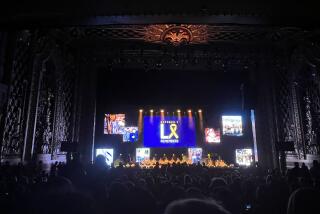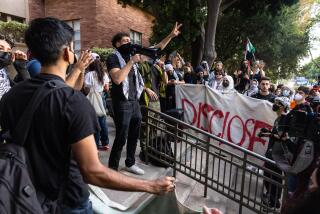Bush Cites âHopeâ That Emerged From Violence of 10 Years Ago
President Bush marked the 10th anniversary of the Los Angeles riots Monday with a visit to South-Central Los Angeles to promote his plans to give religious groups a bigger role in the fight against poverty.
In the heart of a West Adams neighborhood ravaged by fire and looting, Bush recalled the âcivil unrest that made historyâ during the final year of his fatherâs presidency.
Arriving in mid-afternoon, Bush met privately with 20 black, Latino and Asian community leaders at an economic development office of the First African Methodist Episcopal Church.
They told him of efforts to revitalize the impoverished neighborhoods that erupted in riots after white police officers were acquitted in the beating of black motorist Rodney King.
âI fully understand that 10 years ago this city, because of some violence--a lot of violence--saw incredible destruction in lives and in property,â Bush later told 300 guests gathered in a nearby room.
The visit to the churchâs FAME Renaissance Center, which provides aid to small businesses, was Bushâs first stop on a two-day swing through California to raise money for Republican gubernatorial nominee Bill Simon Jr.
Later, Bush was the main attraction at a Simon dinner at the Century Plaza Hotel in Century City. Today, Bush is due to speak at another Simon fund-raiser in the Silicon Valley. Simon said he expects the events to raise more than $4 million.
But more than the fund-raisers, the visit to a neighborhood struck by the riots--a word Bush did not use on the anniversary--drew notice.
At the private session, Bush said, Charles Kim of the Korean American Coalition had told him about âthe dashed dreams of many of the Korean entrepreneursâ whose businesses were destroyed.
âA lot of hopes were lost,â Bush said. âThe violence and the lawlessness always affects the most poor, always hurts the weakest, and yet out of this violence and ugliness came new hope, and we discussed that today.â
The riots that spread across the area 10 years ago were a low point in his fatherâs reelection campaign. While the Bush administration blamed the riots partly on the Great Society programs of the 1960s, Democratic rival Bill Clinton called for more investment in poor neighborhoods and an increase in the minimum wage. Clinton also sought to display his empathy by visiting the devastation days before Bush.
On Monday, Bushâs son called attention to the urban revitalization that has occurred. He noted that much of the improvement came from faith-based programs such as FAME Renaissance, which works with federal aid.
âTen years after civil unrest that made history, the community is rebuilding herself with great hope and great promise, and thatâs an important lesson,â Bush said.
Bushâs proposal to allow religious groups to take on social service functions traditionally performed by government has stalled in Congress. Critics have voiced concern about breaches of the constitutional separation of church and state. Bush rejected that argument Monday.
âI donât want government to be the church, and I donât want the church to be the government,â Bush said. âBut government should not fear faith and faith-based programs.â
âThatâs right!â a voice called from the crowd.
âGovernment should not worry,â Bush continued, âabout programs that come out of church or synagogue or mosque, all aimed at loving a neighbor just like youâd like to be loved yourself. The universal call to love is something to be nourished, not feared. There is a role for government. When we fund programs, we ought not to discriminate against faith-based programs.â
Among those meeting with Bush were the Rev. Cecil âChipâ Murray, senior pastor at First AME church; Bishop Charles E. Blake, pastor of West Angeles Church of God in Christ; John Bryant, founder and chief executive of Operation HOPE, a nonprofit urban renewal group; Antonia Hernandez, president of the Mexican American Legal Defense & Educational Fund; and Kim.
FAME Renaissance is located in a renovated office building on West Adams Boulevard and Western Avenue. Before Bushâs arrival, the Rev. Mark Whitlock, FAMEâs executive director, looked across West Adams Boulevard and recalled the devastation of April 29, 1992. Bottles, bricks and firebombs were crashing through liquor store windows. Flames were shooting out of a nearby office building and apartment complex.
âTen years have gone by, and much has happened, but much needs to be accomplished,â he said. âOne of the most powerful men in the world has an opportunity to see what we see instead of reading what we see. He has resources--not only human, but capital resources to make a significant change.â
Lynn Logwood, 37, a nurse buying groceries across the street, agreed. âWith all the things that are going on in the world today, itâs a good thing that heâs taking the time to come to the community and find out whatâs going on,â she said.
Others were more skeptical.
âWeâre not naive,â said D.A. Ballinger, 48, a vending machine salesman who lives nearby in West Adams. âIf he was coming here saying, âIâm going to sign a bill giving $1 billion to the cities so we can rebuild,â now that I could support. But heâs not doing that. If youâre going to come, come correct. Thatâs what we say in the âhood.â
Gerald Parsky, Bushâs chief political operative in California, said Bushâs visit was meant to show that he âunderstands itâs important to reach out and provide opportunity for people.â
âHeâs a person of inclusion, a president for all the people, and economic development in the inner city is an important part of his program,â Parsky said.
More to Read
Get the L.A. Times Politics newsletter
Deeply reported insights into legislation, politics and policy from Sacramento, Washington and beyond. In your inbox three times per week.
You may occasionally receive promotional content from the Los Angeles Times.











